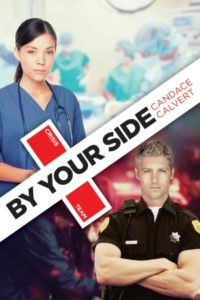When everything goes wrong, where do they put their trust? By Your Side (Tyndale House) is the first volume in Candace Calvert’s Crisis Team series. In this Q&A, she explains the inspiration for her new characters, why she wants to honor volunteer heroes and the challenges of writing medical fiction…
Tell us a little about Macy and Fletcher, the main characters in By Your Side. Are they based on anyone in particular?
 Deputy Fletcher Holt, though not based on a real person, actually appeared as a secondary character in Life Support, the third book in my Texas-set Grace Medical series. I loved his idealism, love for family, his faith—and Fletcher’s deep commitment to “protect and serve,” far beyond his role as a police officer. I had a hard time leaving him behind in Houston, so I brought him to northern California to become the sigh-worthy hero of By Your Side.
Deputy Fletcher Holt, though not based on a real person, actually appeared as a secondary character in Life Support, the third book in my Texas-set Grace Medical series. I loved his idealism, love for family, his faith—and Fletcher’s deep commitment to “protect and serve,” far beyond his role as a police officer. I had a hard time leaving him behind in Houston, so I brought him to northern California to become the sigh-worthy hero of By Your Side.
While ER nurse Macy Wynn is also purely fictional, I loved creating such an independent and take-charge young woman. She is a great mix of at-odds elements: kickboxer and ballerina, streetwise and naive, tough and tenderhearted–and of course, the perfect challenge for Deputy Holt.
How can someone learn more about crisis care teams?
 I’m glad you asked. I’ve written this story—the Crisis Team series—to honor these selfless volunteer heroes. Although the team in By Your Side is fictional, it is based on the service of very real crisis responders. I’m honored to work with local community and law enforcement chaplains in bringing these stories to my readers. Some great information about the work of crisis care teams can be found at these two links:
I’m glad you asked. I’ve written this story—the Crisis Team series—to honor these selfless volunteer heroes. Although the team in By Your Side is fictional, it is based on the service of very real crisis responders. I’m honored to work with local community and law enforcement chaplains in bringing these stories to my readers. Some great information about the work of crisis care teams can be found at these two links:
Law Enforcement Chaplaincy Sacramento
What are some of the unique challenges of writing medical fiction?
Probably the biggest challenge in writing medical fiction is portraying medical scenarios in a realistic, compelling, and clear manner without either “talking down” to readers (people are becoming better informed) or talking “over the heads” of readers—and prompting them to skim.
It’s my goal in writing medical fiction to tell a story in such a way that readers actually feel “dropped into” those adrenaline-spiked scenes. And not just as observers, but as part of the medical team.
You’ve written several books. Of all the characters you’ve written, which character do you most relate to?
(Smile) I’m sure there is plenty of my DNA in the characters I create. They often have my interests, quirks . . . my strengths and challenges, too. In Trauma Plan, nurse Riley Hale struggles to return to her position in the ER after an assault that left her with a damaged arm. Years back, I suffered a very serious equestrian accident that landed me on a trauma gurney in my own ER, with multiple injuries that included a broken neck and a partially paralyzed right arm. I loved sharing the blessing of my own happy ending with Riley—and my readers.
Tell us a little about your family.
Thanks to a loving God of second chances, our wonderful family is a blended one. Between us, my husband (nicknamed “Mr. Bond”) and I have four children and seven grandchildren, ages 3 to 24. Such a joy! We love that our littlest grands are sets of boys and girls of similar ages—sort of bookend cousins. When they all get together, it’s such a crazy-fun mix of ninja warriors, princess power, and never-ending giggles.
Say you have a fan who’s read everything you’ve ever written. What book would you recommend she read next?
First, I’d thank her! And since she likes inspirational medical fiction, I’d likely suggest medical romantic suspense by Dr. Richard Mabry and Dr. Harry Kraus, and medical thrillers by Jordyn Redwood. All very good reads.
More about the book here:


